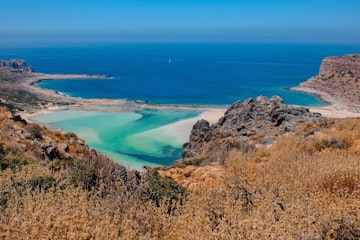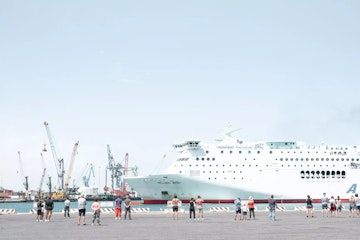Crete spans a whopping 160 miles from end to end as it dashes through the bath-warm waters of the southern Mediterranean. It's Greece's largest island and also its most varied. There are mountains that smash through the clouds to over 2,400 meters right next to deep canyons inhabited by hardy mountain goats. You'll find glimmering lagoons of turquoise water that would look right at home in the Seychelles carving along the coast, hemmed in by venerable olive groves and dusty plateaus dotted with farms.
Truth be told, Crete can sometimes seem like a whole country unto itself. It can take days and days to complete a loop of the craggy isle, dropping from the buzzy beach resorts east of Heraklion to the remote coves of the southern shores. The history and culture and cuisine are palpably different to the rest of Greece, too, what with Venetian windmills and Minoan palaces giving way to tavernas where crispy dakos breads are the order of the day.

This Crete travel guide will showcase all the top things to do and see on the island. It will reveal the top seasons to visit, where the finest beaches await, and how you can expect to arrive in the first place…
Where is Crete, Exactly?
Crete doesn't just have the superlative of being the largest of the Greek islands. It's also the most southerly. Look for its finger-like outline in the very middle of the Med, a touch closer to Africa than to Athens. It actually marks the southern end of the Aegean Sea, and the boundary where that island-hopping mecca turns into the Libyan Sea before rolling all the way south to the next continent. To be honest, this one's so big (the fifth-largest isle in the whole Mediterranean, no less) that you can hardly miss it on the map!

When to Visit Crete
Crete follows the same four-season pattern as the rest of Greece, only here the summer months are elongated, while the winter months are squashed into a short period between December and February. The reason for that is the southerly location. You're nearly 200 miles further south than Athens, and nearly 100 miles further south than the main Cyclades isles of Naxos and Mykonos. That brings more heat during the peak season, along with a few unique climatic changes you don't get elsewhere in the country.
Crete in Winter
Crete is sometimes hailed as a winter-sun hotspot. We'd say consistent rays between December and March are never guaranteed, but they also aren’t rare. What's more, average temperatures dip to a relatively mild 14-15 C throughout the whole season. Rainfall can peak at about 120mm for the month of December but that's skewed because most of the water falls on Crete's high, mountainous terrain. The upshot? There's still a chance you'll score cloudless days for sitting on the beachfront in the winter, but be aware that many of the main resort areas of Malia, Agios Nikolaos, and Rethymno all but shut up shop. That said, winter in Crete is perfect for escaping the crowds at key historical sites like Knossos and central Chania, and pretty decent for hiking too.

Crete in Spring
Visiting Crete in spring might just be the best option of all. Mercury levels start to pick up above the 20 C mark around early April but the main summer crowds aren't anywhere near arriving, so you should find better hotel rates and emptier beaches all round. What's fantastic is that those harsh summer north winds (more on those below) haven't started, so things are way less blustery than in August, too. We especially love exploring the Cretan mountains at this time of year, as the hiking trails are all alight with blazes of multi-coloured wildflowers.

Crete in Summer
Let's get one thing straight: Summer in Crete is hot. Like, very hot. Temperatures are known to peak at around (or even above) the 40 C mark most seasons, and average daily highs even top the 30s. It's not really ideal for doing anything other than lazing on the beaches or by the pool, which is hardly bad news if you're after some hard-earned R&R. One thing to watch out for is the phenomenon of the meltemi winds. They blow in hard and like clockwork throughout July and August, bringing hot and stuffy air all across the whole island. Summer is also busy, with the bulk of the tourists arriving into resorts on the north coast between June and early September.

Crete in Autumn
As the strong winds and soaring temperatures of summer drop away, Crete once again gets a second peak period: The autumn. One bonus of coming this side of the calendar is that the seas will be at their warmest – expect waters of up to 25 C! Air temperatures hover around the balmy-but-not-oppressive 24-28 mark, and the evenings can be cool enough to warrant a jacket. Autumn is another top time for exploring the mountains and the coastal paths with fewer people around, although November is more unpredictable, as the chance of sandstorms coming off the Sahara Desert increases.

Things to Do in Crete
Crete is so big and so varied that it's got things to suit every type of traveller. Lazing on the beach fronts is all fine if that's what you're after (more on those later) but there's adventure, rich history, and enthralling towns on the menu to boot.
Hike the Samaria Gorge
The Samaria Gorge is a breathtaking canyon that slices through the midst of the White Mountains on the south side of the island. It's a mecca for walkers who want to experience what's arguably the most incredible hiking path in the country, weaving through a UNESCO Biosphere where mountain ibex clamber onto precipitous ridges and clusters of Calabrian pine trees scent the air. One thing: Samaria is a bit of a challenge, so bring proper hiking equipment and plenty of water for the day's trek.

Palace of Knossos
Calling all history buffs – the Palace of Knossos is the place to go to get a feel for the long and rich past of this island. Hailed as the oldest city in Europe, this was once the epicentre of the Minoan Civilization, who ruled the southern Aegean Sea between 3500 BC and 1300 BC. The remains of their greatest town can reveal painted courtrooms and throne rooms, along with intricate water systems and ancient ventilation systems. There's also a related museum back in the centre of Heraklion town.
Spinalonga Island
It might seem strange that making a day trip to another island is one of the top things to do in Crete, but really no Crete travel guide could be complete without a mention of Spinalonga. Set in the glimmering Gulf of Elounda, the place is crowned by a dramatic Venetian castle that was once a leper colony. The whole thing was abandoned in the 1950s and you can still see the eerie homes of the onetime invalid inhabitants. A couple of small and stunning pebble beaches can cap off the day's activities.

Explore Chania
Chania is one of the most enchanting towns on Crete. Smaller than the capital in Heraklion, it's the hub of the westernmost portion of the island and even has its own airport. Don't skip it and go straight for the beaches, though. The whole place arcs around a postcard-perfect harbour where the silhouette of a slender Venetian lighthouse looms over the remains of Byzantine port cellars and taverna bars that forever buzz with life. Dive behind the water's edge and you'll find fantastic eateries like Tamam hidden in a maze of back alleys that oozes atmosphere.

Dine on Cretan Food
Cretan food is proudly different to the food of Greece as a whole. Influenced by the Ottomans, the Cyclades isles, North Africa, the Venetians, and the rugged backcountry of the island itself, it's a mishmash of spices and herbs and simple cooking that's difficult not to love. A new breed of modern taverna has started serving Crete's staples in Chania and Heraklion – Tamam, To Koutourouki, Tasting Crete. Be sure to visit one of those to sample the light dakos breads with white cheese, the stewed highland greens, the Cretan cheese pies and smoked pork. Mouth = watering.

The Best Beaches in Crete
Our Crete travel guide has a myriad of beaches to pick from, but we've whittled it down to just five spots that are sure to take your breath away…
Balos Lagoon
Prepare to be stunned by the Balos Lagoon. Looking like something plucked straight out of the Caribbean, this one's got wisps of white sand, weathered rock pools, and curls of halcyon sea waters. It caps off a headland on the extreme north-western edge of the island, opening into a sort of wide bay with sandbanks here and there. Most people take a boat trip to Balos from Kissamos port but there's a true adventure on the rugged coastal hiking path that goes over the mountains.

Falasarna
The mountains tower high and the waves roll in hard at Falasarna, one of the most dramatic sections of shoreline in western Crete. Behind pockets of tomato plantations and zigzagging roads, the sands here roll out for a couple of clicks, going from the private nudist sections in the north to organised sunbed areas in the south. Thanks to the westerly orientation, Falasarna is a fantastic place to go for sunset beers and a sunset swim.
Elafonisi
Elafonisi pokes out of the south coast of Crete beyond the peaks of the White Mountains. It's actually the name of an island that's half joined to the shore by a tidal pool and several sand banks. All of that's washed by the positively balmy Libyan Sea, which also brings in dashes of eroded red coral to give the sands a distinctly pink hue. There are lots of little areas to swim and sunbathe, but be sure to walk at least 10 minutes from the carpark to escape the crowds.

Preveli
Preveli marks the point where big Kourtaliotikos Gorge opens wide to meet the southern seas of the Med. There, it boasts one seriously lovely beachfront made up of grey-tinged pebble rocks and very clear blue waters. It's not the easiest beach on the island to get to – just be ready for a gnarly scramble down the rocks. However, that helps to thin out the visitor numbers and keep it nice and quiet.
Vai
Vai is known for its halo of lush date palms. They lend the beachfront here a whiff of Arabia. Watch them dance in the gusty summer breezes against a shoreline of perfect taupe sand. The beach itself runs out between two scrub headlands, with the oasis palms clustering right in the middle. There's fantastic swimming when the swells are low – a Blue Flag rating attests to that. Sadly, Vai can get busy in the high summer as it's an organised beach with sunbeds for rent.

How to Get to Crete
With Crete being so far south in the Aegean Sea, you might think that it would be one of the harder of the Greek islands to get to. Not so. Crete's size and population mean that it's actually one of the best-connected isles of all. Of course, flight times from hubs in Europe and ferry times from other islands are a little longer, but you've got lots of options for getting in…
Crete Flights
There's good news for those looking to whiz across to Crete direct…this island has two international airports, both of which host loads of low-cost and premium arrivals from across Europe. The largest, Heraklion International Airport, is prime for getting to the resorts of Malia and Bali in eastern Crete. Chania Airport is better for reaching the mountains and remote beaches of western Crete. Expect flight times to be in the region of four hours from London.

Popular Carriers Linking to Crete Include:
- British Airways – The UK flag carrier has a direct seasonal route into both Heraklion and Chania from London Heathrow.
- Ryanair – Ryanair has one seriously wide network of flights that terminate in Crete, with options coming in from Bari, Bergamo, Krakow, Rome, and Manchester to name just a few. They also have some of the lowest airfares on the continent.
- Aegean Airlines – The go-to option for domestic flights within Greece, Aegean Airlines has lots of short-haul links from islands like Rhodes and, of course, Athens. There's also a good network of international flights, mostly to larger European capitals.
Crete Ferries
Crete is usually the ending or starting point of island hopping in Greece. Why? Well…just look where it is on the map. It's not got any really close island neighbours, so coming here and then elsewhere would probably be a hefty detour. That's not to say that there aren't ferries arriving in Crete from places like Mykonos and Rhodes. There are. It's just that they are usually pretty long or even overnight, so it's best to make it a one-way thing.

Popular summertime ferry connections to and from Crete include:
- Athens to Crete (€30-40/9-10 hours) – Minoan Lines run a regular summer ferry up to six times per week from the Greek capital to Heraklion. ANEK Lines run the same route less often but into Chania port.
- Santorini to Crete (€60-70/2 hours) – Superfast Seajet ferries operate on this ever-popular route, bringing the dramatic volcanic island of Santorini into play for island hoppers hoping to see Crete too.
- Peloponnese (Gythio) to Crete (€20/6-7 hours) – A useful but not-often-used ferry route that links the middle of the Peloponnese to western Crete, arriving at Kissamos.
This Crete travel guide outlines the wonders of the country's largest and most unique island, from its soaring mountain landscapes to its gorgeous pebble coves. Crete is a must-see destination to add to any island hopping itinerary.


